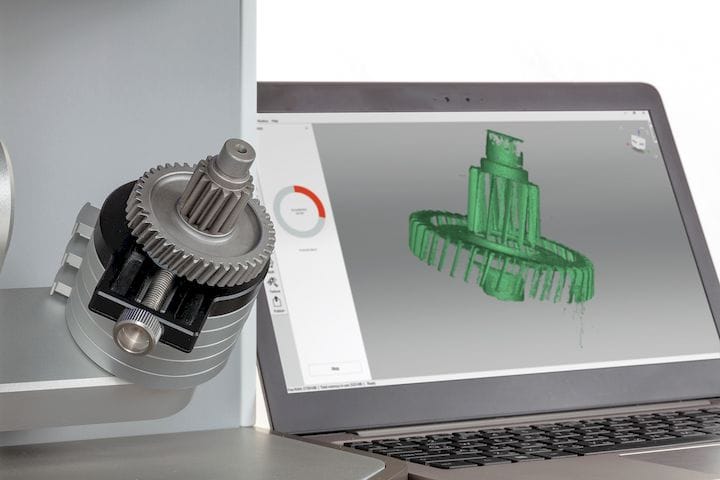![Artec Studio 14 includes powerful 3D scanning features [Source: Artec 3D]](https://fabbaloo.com/wp-content/uploads/2020/05/image-asset_img_5eb0965f24faa.jpg)
Artec 3D released Artec Studio 14, their latest and most powerful version of their 3D scanning management software.
Artec 3D offers a line of multiple types of 3D scanning instruments; some are handheld, others tripod-mounted, and one is even fully portable with onboard processing. They’ve also experimented with an automation system for 3D scanning by using a robotic setup. Their product line seems to cover a huge scope of 3D scanning possibilities, ranging from the ability to capture high-resolution scans of tiny objects, all the way to 3D scans of entire rooms and large buildings.
All of these devices are controlled through the Artec Studio software, which can also process the received scan data and produce useful 3D models. Of course, these scans can be used for reverse engineering or direct 3D printing in some cases.
The latest release, Artec Studio 14, includes a few very interesting features that we haven’t seen in other scanning tools.
Artec 3D has improved their large-scale 3D scanning solution by automating some of the manual work required in setting up their tripod-mounted Ray system. Instead of requiring stationing targets in the scene to assist in calibrating the 3D scene, the software now can take on some or all of this work itself. This should greatly speed up the effort required to capture large scenes, and in some cases enable capture of scenes not previously possible.
If you’re not familiar with the concept of targets in 3D scanning, they are still used with some processes. The idea is to create known fixed locations that can provide the software with a quick way to rapidly interpret the orientation of the received data. However, it requires manual effort to place the targets. This is a case of software ingenuity vs. manual labor, but it seems that Artec Studio 14 turns that equation upside down.
![Artec Studio 14 identifies curves in 3D scanned geometry [Source: Artec 3D]](https://fabbaloo.com/wp-content/uploads/2020/05/image-asset_img_5eb0965f8e9f4.jpg)
Reduce Glare In 3D Scans
One new feature focuses specifically on reverse engineering. Artec Studio 14 is able to identify some geometry in captured scans, and can also export these curves in CSV and DXF file format. These files can be directly imported into several CAD tools, including SOLIDWORKS or similar, and can greatly assist in reverse engineering work. Without these curves, they would have to be manually identified by the CAD operator, a tedious task indeed.
So tedious is that work that those performing reverse engineering often resort to intermediate systems that perform much of this scan interpretation before launching the CAD tool. The big idea here is that, in theory, you could eliminate the need for the intermediate system entirely and jump directly from Artec Studio 14 to CAD. Of course, the curves won’t nearly be as comprehensive an analysis as can be done by dedicated intermediate systems, but for many applications it might just be sufficient.
![Artec Studio 14 can automatically fix glare spots in 3D scans [Source: Artec 3D]](https://fabbaloo.com/wp-content/uploads/2020/05/image-asset_img_5eb0965fd26d9.jpg)
Another very intriguing feature is the glare removal function. Glare is often encountered during a 3D scan, as lighting may bounce off of reflective surfaces. These pollute the scan, mainly by messing with the surface texture, which can have an overblown glare spot. The new Artec Studio 14 can automatically eliminate these. They explain:
“With Studio 14, users can adjust the level of glare removal with a few clicks and watch as the vibrant color of an object is restored, saving hours of work for applications such as 3D printing or CGI. To further ensure a model represents true color, a new Dynamic Auto Brightness feature will automatically tailor the brightness to optimal levels during both the scan preview and the duration of the scanning process. The visual differentiation algorithms can set the correct levels of brightness for both dark and light objects – no matter the lighting conditions.”
Join Two 3D Scans
![Artec Studio 14 can join two 3D scans together very easily [Source: Artec 3D]](https://fabbaloo.com/wp-content/uploads/2020/05/image-asset_img_5eb0966025c8f.jpg)
Sequence animation looks to be a powerful feature to allow two different scans of the same object to be properly joined together. This is an incredibly powerful feature that could make scanning workflows much easier.
It seems Artec Studio 14 just made all of Artec 3D’s line of 3D scanners a lot more powerful, thus proving the critical importance of software for 3D scanning. The best solutions involve both good hardware and good software.
Via Artec 3D











Anna Shcherbinina has been working at Artec 3D for nine years.